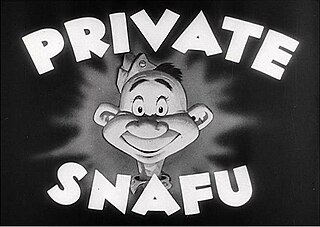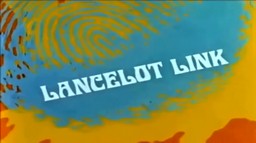
Mad is an American humor magazine first published in 1952. It was founded by editor Harvey Kurtzman and publisher William Gaines, launched as a comic book series before it became a magazine. It was widely imitated and influential, affecting satirical media, as well as the cultural landscape of the 20th century, with editor Al Feldstein increasing readership to more than two million during its 1973–1974 circulation peak.

Sergio Aragonés Domenech is a Spanish/Mexican cartoonist and writer best known for his contributions to Mad magazine and creating the comic book Groo the Wanderer.

Dick Tracy is an American comic strip featuring Dick Tracy, a tough and intelligent police detective created by Chester Gould. It made its debut on Sunday, October 4, 1931, in the Detroit Mirror, and was distributed by the Chicago Tribune New York News Syndicate. Gould wrote and drew the strip until 1977, and various artists and writers have continued it.

Private Snafu is the title character of a series of black-and-white American instructional adult animated shorts, ironic and humorous in tone, that were produced between 1943 and 1945 during World War II. The films were designed to instruct service personnel about security, proper sanitation habits, booby traps and other military subjects, and to improve troop morale. Primarily, they demonstrate the negative consequences of doing things wrong. The main character's name is a play on the military slang acronym SNAFU, "Situation Normal: All Fucked Up".

Danger Mouse is a British animated television series produced by Cosgrove Hall Productions for Thames Television. It features the eponymous Danger Mouse who worked as a secret agent and is a parody of British spy fiction, particularly the Danger Man series and James Bond. It originally ran from 28 September 1981 to 19 March 1992 on the ITV network.

Crazy Magazine is an illustrated satire and humor magazine that was published by Marvel Comics from 1973 to 1983 for a total of 94 regular issues. It was preceded by two standard-format comic books titled Crazy. The magazine's format followed in the tradition of Mad, Sick, Cracked and National Lampoon.

Lancelot Link, Secret Chimp is an American action/adventure comedy series that originally aired Saturday mornings on ABC from September 12, 1970, to January 2, 1971, and rebroadcast the following season. The live-action film series featured a cast of chimpanzees given apparent speaking roles by overdubbing with human voices.

Don Martin was an American cartoonist whose best-known work was published in Mad from 1956 to 1988. His popularity and prominence were such that the magazine promoted Martin as "Mad's Maddest Artist."
Antonio Prohías was a Cuban-American cartoonist. He was the creator of the satirical comic strip Spy vs. Spy, which he illustrated for Mad magazine from 1961 to 1987.

Peter Kuper is an American alternative comics artist and illustrator, best known for his autobiographical, political, and social observations.

Don "Duck" Edwing was an American gag cartoonist whose work has appeared for years in Mad. His signature "Duck Edwing" was usually accompanied by a small picture of a duck, and duck calls were heard on his answering machine. Mad editor John Ficarra said, "He's exactly how people picture a Mad magazine writer." In 2007, Edwing told an interviewer, "I always believed that when you choose your field, you should specialize. You never deviate. I chose 'sick puppy'."

King Kong, commonly referred to as The King Kong Show, is an American-Japanese animated series produced by Videocraft International and Toei Animation. ABC ran the series in the United States on Saturday mornings between September 10, 1966, and August 31, 1969. It is the first anime-based series produced in Japan for an American company.

Captain Klutz is a comic strip character created in 1967 by Don Martin. He is a parody of superhero characters. The character originally saw print in a series of original paperback books done for the Mad magazine paperback line, not the magazine itself.
Woodrow Phoenix is a British comics artist, writer, editorial illustrator, graphic designer, font designer and author of children's books.
Devlin is an American animated television series produced by Hanna-Barbera Productions and broadcast for 16 episodes on ABC from September 7 to December 21, 1974, with reruns airing until September 1976. The series, inspired by the popularity of motorcycle daredevil Evel Knievel, featured a stunt motorcyclist with a traveling circus named Ernie Devlin and his siblings Tod and Sandy. It was one of Hanna-Barbera's few dramatic series.
Mad is known for many regular and semi-regular recurring features in its pages.
The following is a list of reference to Archie Comics in popular culture.

Mad is an American animated sketch comedy television series produced by Warner Bros. Animation. The series was based on Mad magazine, where each episode is a collection of short animated parodies of television shows, films, video games, celebrities, and other media, using various types of animation instead of the usual animation style that Warner Bros. Animation is known for. The series premiered on the evening of September 6, 2010 on Cartoon Network at 8:30 P.M. right after the series premiere of Regular Show. The series ended its three-year run on December 2, 2013.

Jonny Quest is an American animated science fiction adventure television series about a boy who accompanies his scientist father on extraordinary adventures. It was produced by Hanna-Barbera Productions for Screen Gems, and was created and designed by comic book artist Doug Wildey.
"The Lighter Side Of..." is an American satirical comic strip series written and drawn by Dave Berg and published in Mad Magazine from 1961 to 2002.
















